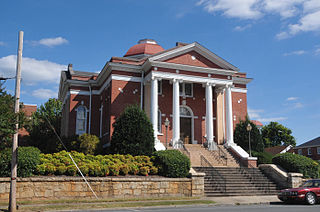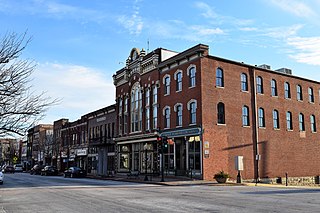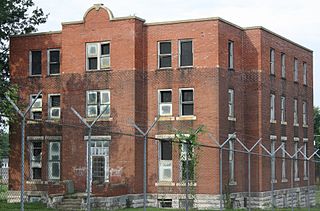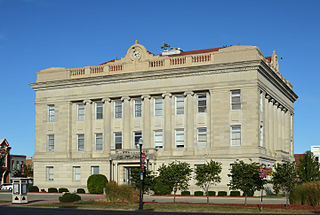
The Downtown Evanston Historic District in Evanston, Wyoming includes about sixty buildings in a compact downtown commercial district.

The Canton Main Street Historic District is a national historic district located at Canton, Haywood County, North Carolina. It includes 34 contributing buildings and one other contributing structure and includes architecture by Benton & Benton. It includes Early Commercial architecture and Late 19th and 20th Century Revivals architecture. Located in the district is the separately listed Colonial Theater. Other notable buildings include the P L & S Building (1932), Champion Fibre Company Office Building (1918), Champion Bank and Trust, Imperial Hotel, and the former United States Post Office (1939).
Morris Frederick Bell was an American architect known primarily for his institutional buildings but also for his domestic and commercial structures. His best known work is the David R. Francis Quadrangle the historic center of the University of Missouri including Jesse Hall. He also designed state correctional schools in Boonville, Chillicothe, and Tipton; and state mental hospitals in Fulton, Higginsville, and Nevada. Bell, a democrat, was also active in civic life. He trained and employed William Lincoln Garver as an assistant. Garver would later go on to have a stand-alone career.

The Sayre Downtown Historic District is a commercial historic district located in downtown Sayre, Oklahoma. The district comprises a three-block area of Main and 4th Streets; it includes 39 buildings, of which 24 are contributing buildings. The oldest buildings in the district date from between 1903 and 1909, when a building boom replaced Sayre's frame downtown buildings with brick Commercial style structures. By the 1920s, the downtown area had reached its current size, and most of the buildings in the district had been built. In the 1920s, U.S. Route 66 was routed through the district, increasing traffic for local businesses. Sayre's Classical Revival post office, a contributing property, was constructed in 1938; the post office includes a Works Progress Administration mural painted in 1940. The downtown remained prosperous until the 1950s, when population decline and the bypassing of Route 66 led to a decrease in commercial activity.

Statesville Commercial Historic District is a national historic district located at Statesville, Iredell County, North Carolina. It encompasses 54 contributing buildings in the central business district of Statesville. The district includes notable examples of Late Victorian architecture dated between about 1875 and 1925. Located in the district are the separately listed U.S. Post Office and County Courthouse and Iredell County Courthouse. Other notable buildings include the First A. R. Presbyterian Church, former County Jail, the U. S. Post Office, former Walton and Gage Store, Miller Block, Madison Building, former Merchants and Farmers Bank (1908), former Carolina Motor Company (1916), former Montgomery Ward Store, and former First National Bank.

Second Street Historic District is a national historic district located at Albemarle, Stanly County, North Carolina. The district encompasses 12 contributing buildings in the central business district of Albemarle. They were built between about 1898 and 1950 and include notable examples of Early Commercial and Late Gothic Revival style architecture. Notable buildings include The Alameda Theater (1916), Albemarle Hotel (1923), First Presbyterian Church (1924), (former) U.S. Post Office (1936), First Baptist Church (1919), Wilhelm Service Station (1950), Central Methodist Church (1908), City Hall (1938), and Hearne Building (1906).

Culver Commercial Historic District is a national historic district located at Culver, Marshall County, Indiana. The district encompasses 14 contributing buildings in the central business district of Culver. It developed between about 1900 and 1935, and includes examples of Italianate, Colonial Revival, and Bungalow / American Craftsman style architecture. Notable buildings include the Osborn Block, Menser Building (1903), Carnegie Library (1916), U.S. Post Office (1935), Service STation, Knights of Pythias Marmont Lodge 231, and State Exchange Bank.

Downtown Monett Historic District is a national historic district located at Monett, Barry County, Missouri. It encompasses 35 contributing buildings in the central business district of Monett. The district developed between about 1892 and 1947, and includes representative examples of Classical Revival and Streamline Moderne architecture. Notable buildings include the Ozark Fruit Growers Association (1926), Armstrong and Sons Grocers (1914), Wilson Opera House (1893), Zumwalt Lunch Stand (1928), Callaway Furniture Store (1916), Hoberg Building (1893), First National Bank, Main Variety (1945), Bill Martin's Chevrolet, Monett State Bank, City Hall and Fire Station, Gas Service Company and Battery Factory (1917), Post Office (1936), and Masonic Temple (1922).

Pleasant Hill Downtown Historic District is a national historic district located at Pleasant Hill, Cass County, Missouri. The district includes 53 contributing buildings, 1 contributing site, and 1 contributing structure in the central business district of Pleasant Hill. It developed between about 1865 and 1959, and includes representative examples of Italianate, Queen Colonial Revival, and Classical Revival style architecture. Notable buildings include the Missouri Pacific Depot (1903), Sinclair Fuel and Service Station, Benson Brothers Lumber Company (1925), J. R. Prewitt & Sons Manufacturing, Inc., Knorpp's Opera House, Wherritt Building (1924), Booth Public Library (1948), Municipal Power Plant (1939), Pleasant Hill Post Office (1938), Tucker Inn (1911), Pleasant Hill City Hall (1959), and Memorial Building (1948).

Missouri State Capitol Historic District is a national historic district located at Jefferson City, Cole County, Missouri. It encompasses 122 contributing buildings in the central business district of Jefferson City. The district developed between about 1850 and 1950, and includes representative examples of Classical Revival, Late Victorian, Queen Anne, Mission Revival, and Modern Movement style architecture. Located in the district are the separately listed Missouri State Capitol, Lohman's Landing Building, Cole County Historical Society Building, Cole County Courthouse and Jail-Sheriff's House, Missouri Governor's Mansion, and Tergin Apartment Building. Other notable buildings include the St. Peter's Roman Catholic Church complex (1881-1883), Margaret Upshulte House, Broadway State Office Building (1938), Supreme Court of Missouri (1905-1906), U.S. Post Office and Courthouse (1932-1934), Lohman's Opera House, Missouri State Optical, First United Methodist Church (1900), Carnegie Public Library (1901), Temple Beth El (1883), and Joseph and Susie Kolkmeyer House.

Blackwater Commercial Historic District is a national historic district located at Blackwater, Cooper County, Missouri. The district encompasses 12 contributing buildings in the central business district of Blackwater. It developed between about 1889 and 1950, and includes representative examples of Late Victorian style architecture. Notable buildings include the Frady Hotel, Adam Schuster Building, Lee O'Neal Hardware Store, and L. F. Berry, John Smith and Lizzie Fisher Building.

New Haven Commercial Historic District is a national historic district located at New Haven, Franklin County, Missouri. The district encompasses nine contributing buildings in the central business district of New Haven. The district developed between about 1890 and 1940, and includes representative examples of Italianate and Art Deco style architecture. Notable buildings include the John P. Altheide Store, Oscar Hoemeyer Hardware Store (1895), New Haven post Office / Farmer's Savings Bank, Frederick W. Pehle Building / Krull's Department Store (1905), Otto Bucholtz Store, and Walt Theater (1940).

South–McDaniel–Patton Commercial Historic District is a national historic district located at Springfield, Greene County, Missouri. The district encompasses 12 contributing buildings in a commercial section of Springfield. The district developed between about 1872 and 1952, and includes representative examples of Late Victorian style architecture. Notable buildings include the Crenshaw Hardware Co. building, Rogers & Baldwin Hardware Co. building, John W. Williams Building, Queen City Meat Market building, and Phoenix Building.

New Franklin Commercial Historic District, also known as Downtown New Franklin, is a national historic district located at New Franklin, Howard County, Missouri. The district encompasses 19 contributing buildings and 1 contributing object in the central business district of New Franklin. It developed between about 1894 and 1931 and includes representative examples of Queen Anne and Romanesque Revival style architecture. Notable contributing resources include the John B. and Logie R. Fleet House, U.S. Post Office, Home Electric Company Office, Carpenter and White Building, Bethke's German Cash Store (1909), Citizen's Bank (1894), and Santa Fe Trail Marker (1913).

Fayette Courthouse Square Historic District is a national historic district located at Fayette, Howard County, Missouri. The district encompasses 35 contributing buildings in the central business district of Fayette. It developed between about 1828 and 1947 and includes representative examples of Second Empire, Italianate, and Romanesque Revival style architecture. Located in the district is the separately listed Dr. Uriel S. Wright Office. Other notable buildings include the Fayette Public Library (1914), City Hall (1925), New Opera House Block (1903), A. F. Davis Bank, Commercial Bank (1910), The New Century Block Building (1902), Bell Block Building (1883), U.S. Post Office Building (1925), Howard County Jail and Residence, and Howard County Courthouse (1887).

Downtown Webb City Historic District is a national historic district located at Webb City, Jasper County, Missouri. The district encompasses 43 contributing buildings in the central business district of Webb City. It developed between about 1883 and 1965 and includes representative examples of Italianate, Renaissance Revival, Romanesque Revival, Art Deco, and Streamline Moderne style architecture. Located in the district is the previously listed Middle West Hotel. Other notable buildings include the National Bank, S. Morris Department Store, Morris Opera House and Royal Furniture Co., The Unity Building and Merchant and Miners Bank, Aylor Building / Odd Fellow Hall, Mystic Theater, Newland Hotel, Dickenson Theater, Civic Theater, U.S. Post Office, and the Old U.S. Post Office / Wagner Building.

Courthouse Square Historic District is a national historic district located at Chillicothe, Livingston County, Missouri. The district encompasses 24 contributing buildings in the central business district and surrounding residential area of Chillicothe. It developed between about 1877 and 1950, and includes representative examples of Late Victorian and Beaux Arts style architecture. Notable buildings include the Livingston County Courthouse (1914), Wallbrunn Building, First National Bank Building #2 (1906), Peoples Trust Building, Nick J. Rensch Building, Davis/Milbank Building, Leeper Hotel, Chillicothe City Hall (1926), First National Bank Building #1 (1887), and Sipple Clothing Co/Broyles Land Co Building.

Chillicothe Industrial Home for Girls, also known as Chillicothe Correctional Center, is a national historic district located at Chillicothe, Livingston County, Missouri. The district encompasses 10 contributing buildings, 1 contributing site, and 7 contributing structures, at a former industrial home. It developed between about 1889 and 1970, and includes representative examples of Colonial Revival and Streamline Moderne style architecture. Notable buildings include the McReynolds Cottage (188-1889) by Morris Frederick Bell, who also designed the original campus; Blair Cottage (1957-1958); Hearnes Office Building and Clinic (1967-1968); Donnelly Cottage (1957-1958); Stark Cottage (1937-1938); Hyde School (1922); Park Cottage (1937-1938); Food Service Building (1957-1958); Laundry ; Power House. The home officially closed as a juvenile facility in 1980 and re-opened as an adult correctional center in 1981. The new Chillicothe Correctional Center opened in 2008, and the former Industrial Home site was declared surplus.

La Plata Square Historic District is a national historic district located at La Plata, Macon County, Missouri. The district encompasses 36 contributing buildings, 1 contributing site, and 1 contributing structure in the central business district and surrounding residential area of La Plata. It developed between about 1855 and 1958, and includes representative examples of commercial architecture. Notable contributing resources include the La Plata Public Square (1855), Home Press Building, Farmer's and Merchants Bank, Myron Sears Variety, Masonic Hall/La Plata State Bank, Tonkinson and Harris Ford Dealership, The Famous (1908), Wheatcraft Motor Company (1924), La Plata Fire Department, and Post Office (1937).

High Point Historic District is a national historic district located at High Point, Moniteau County, Missouri. The district encompasses seven contributing buildings in the central business district of High Point. It developed between about 1874 and 1954, and includes representative examples of commercial architecture. Contributing buildings include the J. F. Tising & Sons Store, East Tisinq Store Building / IOOF Meeting Hall, Post Office, McGill Cafe / Residence, and two frame and one brick privy.






















